Allons à Lafayette* (Guest post by Maren)
Last month, I was strongly urged to attend a two-hour Friday meeting about boring library stuff in Lafayette, a little over three hours from where I live in north Louisiana. Considering that the state (my employer) will only pay for 99 miles’ worth of my gas, that the Lafayette area is home to some of the best food and most interesting history in Louisiana, and that it would have been a hassle to leave my dog Lola at the kennel, I decided to take her along and get my money’s worth with a mini-vacation.

I was worried that it might be too warm for Lola to wait in the car during the meeting, so I arranged for her to stay at a doggy daycare for the morning. As it turned out, the day stayed quite cloudy and cool, but at least she had fun! (I could tell because she was thoroughly exhausted. Her preferred method of playing with other dogs involves her zigzagging around them at 90 miles an hour while they stare in bewilderment.) After the meeting, I picked up a shrimp po’ boy** from Olde Tyme Grocery and headed with Lola to one of TWO replica Cajun villages in Lafayette.
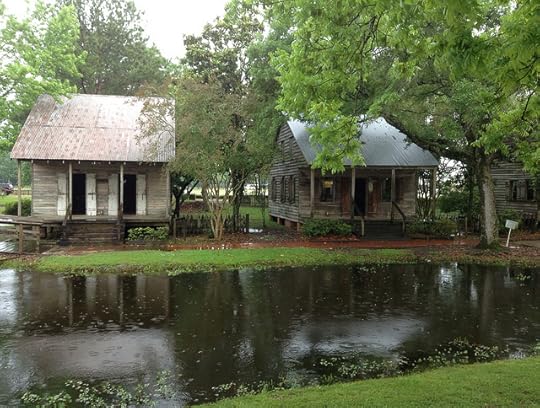
Acadian Village in the rain
I’d already been to the other one, Vermilionville, on a previous trip, plus Acadian Village was listed on a pet travel website as being dog-friendly. As it turned out, only their on-site campground allows dogs, but by then it was raining and Lola was more than happy to sleep off her daycare experience in the car. The village brings together several vintage buildings to give visitors an idea of how Cajuns lived in the 18th and 19th centuries. The French-speaking Cajuns (or Acadians) wound up in south Louisiana starting in the 1760s, after they were expelled from Nova Scotia by the British. (Many had refused to pledge loyalty to the king, which required renouncing Catholicism.) They were dispersed all over North America and Europe, but eventually a few thousand settled in the prairies and bayous of modern-day Louisiana***, which was owned by Spain at the time. It was not easy to make a living in the hot, humid, waterlogged territory, but the Cajuns survived and developed a tight-knit culture characterized by boisterous music and dancing, good hearty food, and good cheer. Today there are over 400,000 people of Cajun descent living in Louisiana.

After Acadian Village, we went to walk around downtown Lafayette. It was still raining, so between holding Lola’s leash, fumbling with my umbrella, and stepping in a puddle that soaked all the way through my shoe…I didn’t get any pictures. Well, not of the city anyway:
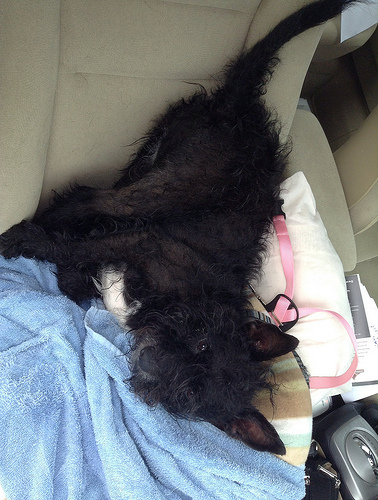
The Contortionist
I dried Lola off as well as I could before putting her back in the car, but it was not to her satisfaction and she did her best to rub on the seat. There was also maybe just a hint of resistance to having her seat belt put back on for the nth time that day. I scrapped plans to visit a nature park that was undoubtedly a mass of mud at that point, picked up dinner from Johnson’s Boucanière (the Parrain Special: a boudin ball and pulled pork smashed on a bun with melted cheese and barbecue sauce), and headed to the plantation cabin I’d rented near Arnaudville about 20 miles north of Lafayette.


Are you wondering if it was a slave cabin? So am I, but I was too chicken to ask. Obviously it would not have been done up cute back then. Although slave quarters in other parts of the South had dirt floors, they were raised in Louisiana due to frequent flooding.

For about the same as I would have paid for a lower-mid-range hotel room in Lafayette, I got a blissfully quiet, private cabin with a kitchen, separate bedroom, breakfast ingredients, snacks and beverages, and LOTS OF WINDOWS for Lola to look out of. This is a big deal, as my townhome doesn’t have any windows at her level.
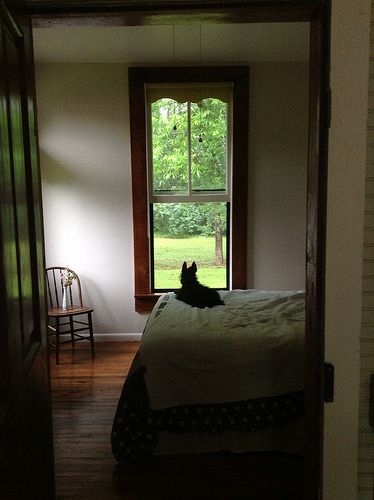
I brought our own blanket to put over the bedspread for just this reason.
And it was just fine that we weren’t staying in Lafayette, since the plan for Saturday was to do a loop of the smaller towns around it…starting with:


Breaux Bridge
Central Breaux Bridge is packed with antique shops, sidewalk cafés, and B&Bs like the one above. One of the cafés hosts a Zydeco breakfast every Saturday morning for people who can eat a full meal and dance starting at 8:30 a.m. I was aware that this is a popular event, but didn’t quite anticipate traffic remaining at a standstill by mid-morning! (This may have been compounded by the fact that it was Mothers’ Day weekend.) But we still had a nice walk through town before heading on to St. Martinville.


Longfellow-Evangeline State Historic Site
Named for Longfellow’s tragic (and probably purely fictional) poem about Evangeline and Gabriel who were separated by the le Grand Dérangement, this was Louisiana’s first state park. It contains the genuine Creole**** plantation house and outbuildings you see here, as well as a replica Acadian farmstead and extensive grounds full of live oaks dripping with Spanish moss. There are regular guided tours of the buildings, but unlike the previous day it was now too warm to leave Lola alone in the car that long. We peeked into the house through the French doors and walked over to the Acadian farmstead, then got back on the road for the short trip downtown.

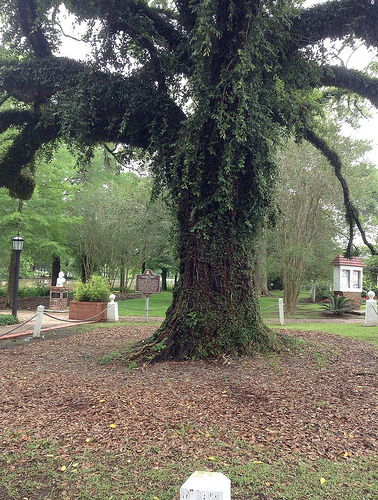
Evangeline Oak, St. Martinville
Live oaks are serious business. Many of those over 100 years old in south Louisiana have names and are members of the Live Oak Society. But the one that draws the most tourists is undoubtedly the Evangeline Oak on the banks of Bayou Teche in St. Martinville. Despite the name, it almost certainly has nothing at all to do with Evangeline, since she probably didn’t exist. Local tourism officials and businesses are quite happy for you to think it’s where she pined for Gabriel or some such, though! In any case it’s still quite impressive with its coat of resurrection fern.

Next stop was New Iberia, where I picked up a roast beef po’ boy from Bon Creole Lunch Counter and devoured it on a bench facing Bayou Teche. We peered through the fence at Shadows-on-the-Teche and strolled a few blocks to a Catholic grotto right next to the public library. Although it was only in the low 80s, not terribly hot for Louisiana, it was characteristically humid and Lola was wilting. I regretfully decided to skip the towns of Rayne (self-proclaimed Frog Capital of the World) and Church Point, so we took a complicated shortcut along secondary state highways to Sunset and Janise’s Supermarket. As you can see at the link they’re supposed to have great boudin, but if the boudin experts say it’s “[n]ot subtle hot, but Hot Hot” I’m pretty sure it’s about 100 times too hot for me. (Even though I’ve gotten better about this since moving here. I put Tabasco in my scrambled eggs for the first time a few weeks ago!) Instead, I got some red beans and rice and fried okra to have for dinner back at the cabin and headed to one last stop in neighboring Grand Coteau…

St. Charles Borromeo Catholic Church

On Sunday we had a leisurely drive back home*****, stopping in Opelousas for one more replica village and at Chicot State Park near Ville Platte:
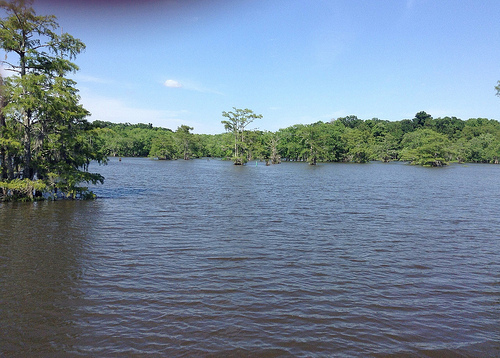
Chicot State Park
I have a lot more photos but I’m already wondering if I should have split this post in two, so if you want to see them feel free to peruse my Flickr set here. Thanks for reading!

*”Let’s go to Lafayette”; title of the first Cajun song recorded and released in 1928.
**I realize some readers may not be intimately familiar with Louisiana cuisine, and I pity them. :) A po’ boy (or poor boy, or po-boy) is somewhat similar to a submarine sandwich, served on a soft French loaf. If you get a seafood one (shrimp, crawfish, clam, or oyster), the filling is usually breaded and fried, making for just a bit of a carb overload. Other key facets of Louisiana cooking: boiled crawfish. Boudin. Red beans and rice. Gumbo, jambalaya, étouffée. Muffulettas. Alcohol.
***At the time, the territory of Louisiana encompassed all of what is now called the Louisiana Purchase, which stretched through the Great Plains and Rocky Mountains all the way up to the Canadian border. But the Louisiana Cajuns mostly settled within “the boot” that we know and love today.
****Creole is not the same as Cajun/Acadian; in Louisiana, Creole referred to people descended from French or Spanish colonists (and often from slaves as well) rather than from the Acadian refugees. On the whole, Creoles tended to be wealthier than Cajuns.
*****Unfortunately it was so leisurely that we arrived at Lea’s Lunchroom in Lecompte after they’d closed and I couldn’t get any PIE.
Robin McKinley's Blog
- Robin McKinley's profile
- 7247 followers



